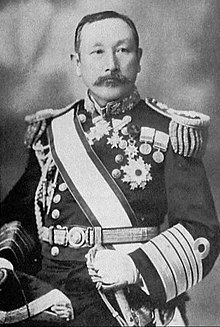Uryū Sotokichi
Uryū Sotokichi ( Japanese 瓜 生 外 吉 ; born January 27, 1857 ( traditionally : Ansei 4/1/2) in Kanazawa , Kaga Province ; † November 11, 1937 in Tokyo ) was a Japanese admiral .
Uryū is best known today for his services in the Russo-Japanese War of 1904/05. He served as a commander in the naval battle at Chemulpo against the Russian warships Varyag and Korejez as well as in the sea battle at Tsushima .
Life
Uryū became one of the first cadets at the Academy of the Imperial Japanese Navy . On June 9, 1875, he was sent to the United States Naval Academy in Annapolis ( Maryland sent). After completing his training, he returned to Japan on October 2, 1881.
In the 1880s he served on board various ships, including the corvette Kaimon , the ironclad Fusō and the armored cruiser Nisshin . On July 23, 1891, he took over his first command on the gunboat Akagi . In 1891 he was promoted to captain at sea . From September 5, 1892 to August 31, 1896, he was sent to France as a naval attaché .
After the outbreak of the First Sino-Japanese War , Uryū took over command of the gun cruiser Akitsushima for a short time . He then commanded his previous ship, the Fusō .
A brief jail stay in 1898 did not seem to harm his career. On February 1, 1898, he was appointed captain of the protected cruiser Matsushima . On June 16, 1898, he took command of the battleship Yashima . On May 21, 1900 Uryū was appointed Rear Admiral and Head of Admiralty Staff.
On June 6, 1904, Uryūs was promoted to Vice Admiral. During the Russo-Japanese War, Uryū commanded the Japanese squadron in the naval battle at Tschemulpo. Uryū had the Korean port of Incheon blocked, in which the Russian ships Varyag and Korejez anchored. Their attempt to break out on February 9, 1904 blocked Uryū successfully, so that both Russian ships had to return to the port and were sunk there by their crews themselves. For this achievement, he was awarded the Order of the Rising Sun ( Kyokujitsushō ) 1st class and the Order of the Golden Weih ( Kinshi kunshō ) 2nd class in 1906 .
Uryū was appointed commander of the Sasebo Naval District ( 佐世保 鎮守 府 , Sasebo chinjufu ) of the Coastal Defense on November 22, 1906 . On September 21, 1907, Uryū received the title of Danshaku ( baron ) and thus became a noble Kazoku .
This was followed on December 1, 1909, the appointment as commander of the marine district Yokosuka ( 横須賀 鎮守 府 , Yokosuka chinjufu ). On October 16, 1912, Uryū was promoted to admiral. As the official representative of Japan, he took part in the opening ceremony of the Panama Canal in the same year . From 1922 to 1925 he was a member of the upper house of the Japanese Reichstag, the Kizokuin .
Uryū retired in 1927. His grave is in Aoyama Cemetery in Tokyo.
literature
- Andidora, Ronald: Iron Admirals: Naval Leadership in the Twentieth Century. Greenwood Press, 2000, ISBN 0-313-31266-4
- Trevor N. Dupuy : Encyclopedia of Military Biography. IB Tauris & Co Ltd, 1992, ISBN 1-85043-569-3
- Jukes, Jeffery: The Russo-Japanese War 1904-1905. Osprey Publishing, 2002, ISBN 1-84176-446-9
Web links
- Uryu Sotokichi in the list of officers of the Imperial Japanese Navy
- Description of the naval battle at Tschemulpo , English
| personal data | |
|---|---|
| SURNAME | Uryū, Sotokichi |
| ALTERNATIVE NAMES | 瓜 生 外 吉 (Japanese) |
| BRIEF DESCRIPTION | Japanese admiral |
| DATE OF BIRTH | January 27, 1857 |
| PLACE OF BIRTH | Kanazawa |
| DATE OF DEATH | November 11, 1937 |
| Place of death | Tokyo |
